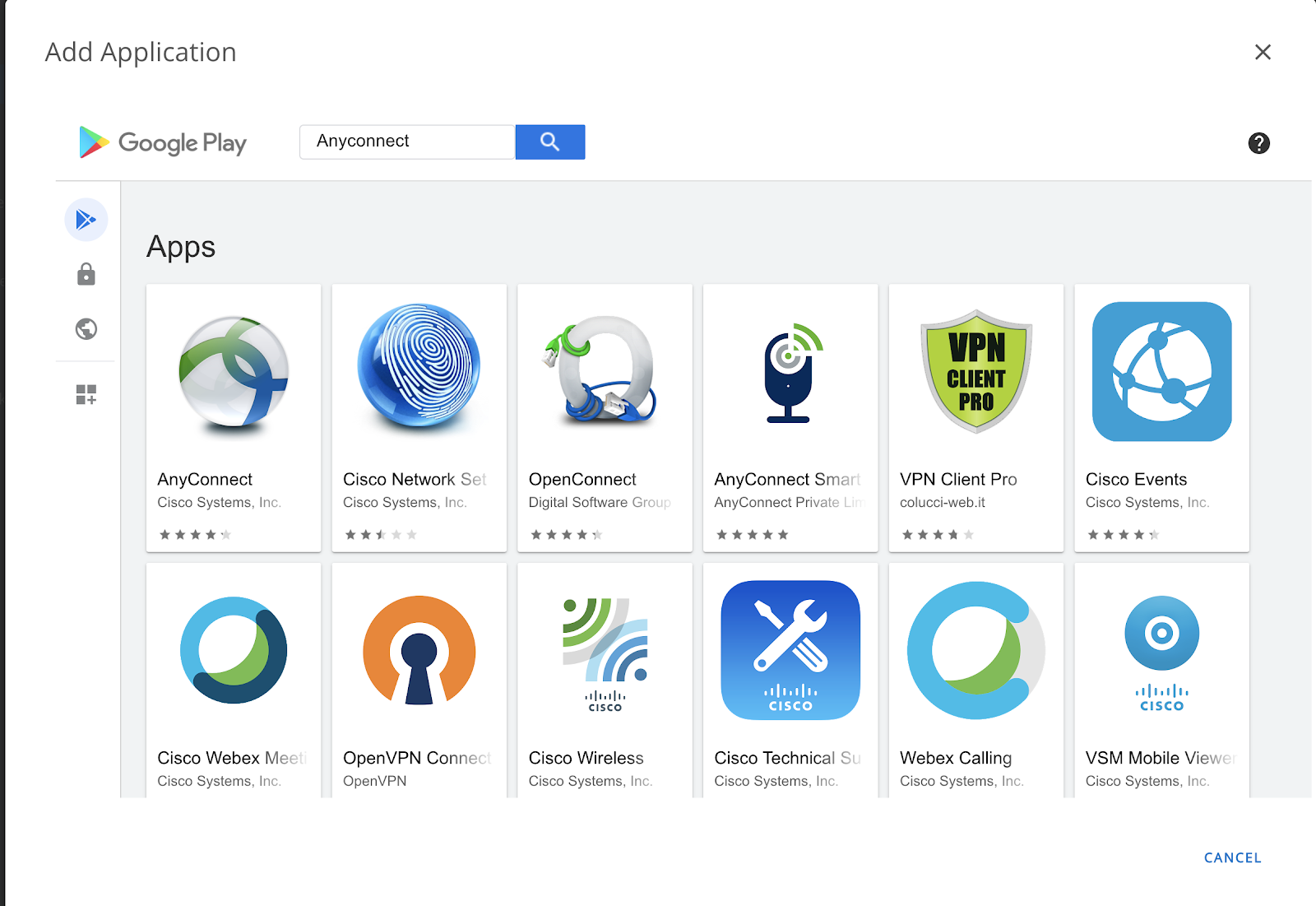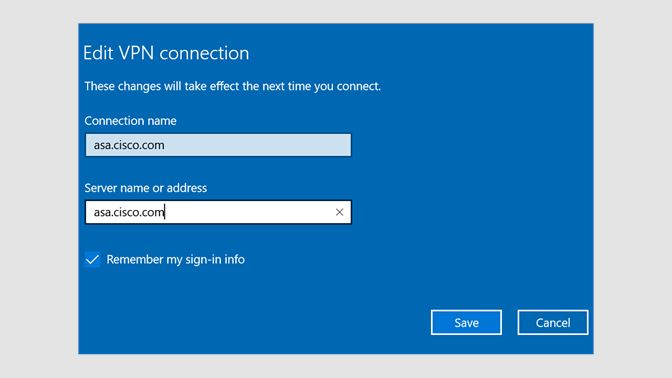NOTE: To provide a simplified, consistent, and reliable VPN experience, all VPN connections will be through remotevpn.wwu.edu beginning Tuesday, January 12. You will no longer use securevpn.wwu.edu for any connections.
- Beginning January 12, all VPN users should connect to remotevpn.wwu.edu
- If your Cisco AnyConnect client currently connects to securevpn.wwu.edu, simply highlight the address and select or type remotevpn.wwu.edu
- The AnyConnect client will remember remotevpn.wwu.edu for future connections
Install Cisco AnyConnect app from the Apple App Store or Google Play Store. Open the Cisco AnyConnect app. Select Add VPN Connection. Enter a Description, for example, CMU VPN and the Server Address vpn.cmu.edu. If prompted, allow the changes. Note: Mobile VPN updates and versions do not coincide with Windows and Mac installations. Cisco Jabber™ for Android is a collaboration application that provides presence, instant messaging (IM), cloud messaging, voice and video calling, voicemail capabilities on Android phone, tablet and Android Wear devices. Escalate your Jabber calls into multi-party conferencing with Cisco Webex® Meetings. This integrated collaboration experience works with both on premise and cloud-based. Installing Cisco AnyConnect Client on Android Devices Cisco AnyConnect is also available as a mobile application for Android devices, however it can only be downloaded via the Google Play Store or another Android Marketplace 1. From your Android Device, go to Google Play Store and search for ‘Cisco Anyconnect.’. Cisco AnyConnect - Empower your employees to work from anywhere, on company laptops or personal mobile devices, at any time. AnyConnect simplifies secure endpoint access and provides the security necessary to help keep your organization safe and protected.
This change is occurring to allow Western to consolidate all VPN access to a single service, reducing cost and complexity. If you already have access to administrative applications via securevpn.wwu.edu, you will be able to access those same applications using remotevpn.wwu.edu.
_______________________________________________________________________________________________
Virtual Private Network (VPN) is a secure way to connect to Western's network from home or while traveling. You need an existing internet connection before you can connect to our VPN server. VPN is useful for the following situations:
- Some campus servers and resources require a VPN connection if you want to access them from off-campus. Mapped network drives are the most common example. You do not need to use VPN to access Canvas, your Western email, OneDrive, or other Office 365 apps.
View a list of services that require VPN from off-campus. - If you are using a public Wi-Fi connection from somewhere like a hotel, cafe, foreign country, or airport, however, connecting to our VPN will add an additional layer of security, so you may want to connect to our VPN even if it is possible to access the services you need without it.
- Some secure resources require VPN even when you are on campus, but only a small number of staff need VPN for this purpose.
Installation
Standard VPN Access from Off-Campus
Fashion model poses sketch. Faculty, staff, and students can use this service from off-campus.
- Install VPN from off-campus using this link: https://remotevpn.wwu.edu.
- This website is not accessible from Western's wired or wireless networks. Currently, Microsoft Edge (non-Chromium-based) does not load the installer correctly on or off of campus, so using Chrome, Firefox, Internet Explorer, Chromium-based Edge or Safari is advised.
- When prompted, enter your Universal username and password.
- After you sign in, Windows and macOS users will be presented with a download button for the Cisco AnyConnect client.
- Chromebook users will need to get the Cisco AnyConnect client from the Chrome Web Store, iOS users can get it from the Apple App Store, and Android users can get it from the Google Play Store.
- After installation, the client will automatically start and connect to WWU. Later, you can access the client by going to:
- Windows: Start > Programs > Cisco
- Mac: Applications > Cisco
- When you click the Connect button, the client should connect automatically to the WWU VPN server. If the 'Connect to' field is blank, enter the address of the VPN server: remotevpn.wwu.edu
Administrative Services VPN (Admin VPN)
Faculty and staff who need to access to services listed in the Admin VPN section of our Do you need VPN? page need to fill out this VPN Access Esign form. Once your Esign form has been locked you can install the VPN client from the following location (Note that it is different from Standard VPN):

- Install VPN using this link: https://remotevpn.wwu.edu
- When prompted, enter your Universal username and password.
- After you sign in, Windows and macOS users will be presented with a download button for the Cisco AnyConnect client.
- Chromebook users will need to get the Cisco AnyConnect client from the Chrome Web Store, iOS users can get it from the Apple App Store, and Android users can get it from the Google Play Store.
- After installation, the client will automatically start and connect to WWU. Later, you can access the client by going to:
- Windows: Start > Programs > Cisco
- Mac: Applications > Cisco
- When you click the Connect button, the client should connect automatically to the WWU VPN server. If the 'Connect to' field is blank, enter the address of the VPN server: remotevpn.wwu.edu
Student Access to VPN
Beginning Spring 2020: All students now have access to use https://remotevpn.wwu.edu.
Full Tunnel or Split Tunnel?
As of November 2020, the following option is available for remotevpn.wwu.edu Citrix desktop viewer.
- When you are traveling, you generally want to select Full Tunnel so all of your network traffic is encrypted by the VPN.
- When you are at home, Split-Tunnel may be the better option. Split Tunnel allows you to communicate with other devices on your local network, like networked printers. This option encrypts only the traffic between you and WWU systems.
- If you are using software like Windows Remote Desktop to connect to your office computer from off-campus (or other remote computer like a laptop), you can use either split or full tunnel from the off-campus computer. If you remote into your office computer and need to use VPN on that computer (required for ODBC connections to databases behind our firewall) you must select Split Tunnel on your office/campus computer.
Cisco AnyConnect VPN Client Updates
If you connect to remotevpn.wwu.edu using an outdated Cisco AnyConnect Secure Mobility client for Mac OS-X or Windows, the client will automatically exit if an update exists. Then the Cisco AnyConnect Secure Mobility Client Downloader will automatically download and install the updated client. Once the update completes, the VPN client should automatically connect. The process should take no more than a few minutes, depending on the speed of your Internet connection.

Google Play Store Cisco Anyconnect
You may be asked if you want to allow Cisco Secure Desktop - Hostscan Launch Utility to make changes to your computer. Click the Yes button, along with your password, if required.
Connecting to Resources
Once connected, you can connect to your network drives, use Outlook, or run Remote Desktop to access your office computer. See instructions on mapping network drives.

Mobile Devices
The free Cisco AnyConnect Secure Mobility Client is available for iOS and Android.
- Install the app
- Make sure you are connected to the Internet and then open the AnyConnect app and add a VPN connection to the following Server Address: remotevpn.wwu.edu
- Enable the AnyConnect VPN by sliding the switch from left to right.
- Enter your Western Universal Username and Password as you would enter it for myWestern.
- You will see a VPN icon next to the Wifi (or cellular data) icon on your device.
Important Considerations
- VPN is a shared resource with limited connections. Please make sure that you disconnect when not using this resource.
- Avoid sensitive transactions like online banking and accessing any site where you need to provide personal information (e.g., passwords, SSN, date of birth) over public Wi-Fi.
- Any service that you sign into using a Web browser should use encryption. Sites that use encryption are those that begin with https:// instead of http:// (note the “s” after “http”). An example is https://login.microsoftonline.com used for Office 365.
Objective
The objective of this document is to provide details about the supported operating systems (Windows, Linux, Mac) of the Cisco AnyConnect Secure Mobility Client and their requirements.
The Cisco AnyConnect Secure Mobility Client, also known as the Cisco AnyConnect VPN Client, is a software application for connecting to a Virtual Private Network (VPN) that works on various operating systems and hardware configurations. This software application makes it possible for remote resources of another network become accessible as if the user is directly connected to the network, but in a secure way. Cisco AnyConnect Secure Mobility Client provides an innovative way to protect mobile users on computer-based or smart-phone platforms, providing a more seamless, always-protected experience for end users, and comprehensive policy enforcement for an IT administrator.
For additional information on AnyConnect licensing on the RV340 series routers, see this article .
Software Version
- AnyConnect Secure Mobility Client 4.9.x | (Download latest)
AnyConnect Supported Operating Systems and Requirements
AnyConnect Support for Microsoft Windows
Windows Operating Systems
- Microsoft-supported versions of Windows 10 for ARM64-based PCs
- Windows 7 Special Pack (SP) 1
- Windows 8
- Windows 8.1
- Windows 10 x86 (32-bit) and x64 (64-bit)
Windows Requirements
- Pentium class processor or greater
- 100 MB hard disk space
- Microsoft Installer version 3.1
- Upgrading to Windows 8.1 from any previous Windows release requires you to uninstall AnyConnect, and reinstall it after your Windows upgrade is complete.
- Upgrading from Windows XP to any later Windows release requires a clean install since the Cisco AnyConnect Virtual Adapter is not preserved during the upgrade. Manually uninstall AnyConnect, upgrade Windows, and then reinstall AnyConnect manually or via WebLaunch.
- To start AnyConnect with WebLaunch, you must use the 32-bit version of Firefox 3.0+ and enable ActiveX or install Sun JRE 1.4+.
- ASDM version 7.02 or higher is required when using Windows 8 or 8.1
AnyConnect Support for Linux
Linux Operating Systems
- Linux Red Hat 6
- Linux Red Hat 7
- Linix Red Hat 8.2
- Ubuntu 16.04 Long Term Support (LTS)
- Ubuntu 18.04 (LTS)
- Ubuntu 20.04 (LTS) (64-bit only)
Linux Requirements
- x86 instruction set
- 64-bit processor
- 32 MB Random Access Memory (RAM)
- 20 MB hard disk space
- Superuser privileges are required for installation
- libstdc++ users must have libstdc++.so.6 (GLIBCXX_3.4) or higher, but below version 4
- Java 5 (1.5) or later. The only version that works for web installation is Sun Java. You must install Sun Java and configure your browser to use that instead of the default package.
- zlib — to support SSL deflate compression
- xterm — only required if you're doing initial deployment of AnyConnect via Weblaunch from ASA clientless portal
- gtk 2.0.0
- gdk 2.0.0
- libpango 1.0
- iptables 1.2.7a or later
- tun module supplied with kernel 2.4.21 or 2.6
AnyConnect (Versions 4.8 and above) Support for macOS
Supported Operating Systems
- macOS 10.13
- macOS 10.14
- macOS 10.15 ( Details from Apple | AnyConnect 4.8 Release Notes)
- macOS 11.x (AnyConnect macOS 11 Big Sur Advisory)
AnyConnect (Versions 4.7 and below) Support for Mac OS X
Supported Operating Systems
- Mac OS X 10.10
- Mac OS X 10.11
- macOS 10.12
- macOS 10.13
- macOS 10.14
Mac OS X Requirements
- AnyConnect requires 50 MB of hard disk space.
- To operate correctly with Mac OS X, AnyConnect requires a minimum display resolution of 1024 by 640 pixels.
Install Cisco Anyconnect
Check out the AnyConnect Release Notes, for the most updated information.

